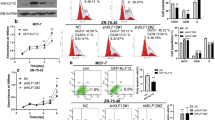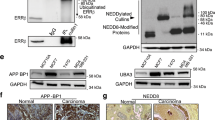Abstract
Kruppel-like factor 4 (KLF4) is a transcription factor that participates in both tumor suppression and oncogenesis. To determine the association of KLF4 with tumorigenesis, we integrated data assembled in the Oncomine database and discovered a decrease in KLF4 gene transcripts in breast cancers. Further analysis of the database also showed a correlation between KLF4 expression and estrogen receptor-α (ERα) positivity. Knockdown of KLF4 in MCF-7 cells elevated the growth rate of these cells in the presence of estrogen. Therefore, we examined the interaction between KLF4 and ERα, and found that KLF4 bound to the DNA-binding region of ERα. KLF4 thus inhibits the binding of ERα to estrogen response elements in promoter regions, resulting in a reduction in ERα target gene transcription. Earlier studies have reported that KLF4 is transcriptionally activated by p53 following DNA damage. We also showed that activation of p53 decreased the transcriptional activity of ERα by elevating KLF4 expression. Our studies discovered a novel molecular network between p53, KLF4 and ERα. As both p53 and ERα are involved in cell growth and apoptosis, these results may explain why KLF4 possesses both tumor suppressive and oncogenic functions in breast cancers.
This is a preview of subscription content, access via your institution
Access options
Subscribe to this journal
Receive 50 print issues and online access
$259.00 per year
only $5.18 per issue
Buy this article
- Purchase on Springer Link
- Instant access to full article PDF
Prices may be subject to local taxes which are calculated during checkout






Similar content being viewed by others
References
Blanchon L, Nores R, Gallot D, Marceau G, Borel V, Yang VW et al. (2006). Activation of the human pregnancy-specific glycoprotein PSG-5 promoter by KLF4 and Sp1. Biochem Biophys Res Commun 343: 745–753.
Bissonnette N, Hunting DJ. . (1998). p21-induced cycle arrest in G1 protects cells from apoptosis induced by UV-irradiation or RNA polymerase II blockage. Oncogene 16: 3461–3469.
Chambon P . (1996). A decade of molecular biology of retinoic acid receptors. FASEB J 10: 940–954.
Chen X, Whitney EM, Gao SY, Yang VW. . (2003). Transcriptional profiling of Krüppel-like factor 4 reveals a function in cell cycle regulation and epithelial differentiation. J Mol Biol 326: 665–677.
Dorgan JF, Longcope C, Stephenson Jr HE, Falk RT, Miller R et al. (1996). Relation of prediagnostic serum estrogen and androgen levels to breast cancer risk. Cancer Epidemiol Biomarkers Prev 5: 33–39.
Evans PM, Liu C . (2008). Roles of Krüpel-like factor 4 in normal homeostasis, cancer and stem cells. Acta Biochim Biophys Sin 7: 554–564.
Finak G, Bertos N, Pepin F, Sadekova S, Souleimanova M, Zhao H et al. (2008). Stromal gene expression predicts clinical outcome in breast cancer. Nat Med 5: 518–527.
Foster KW, Frost AR, McKie-Bell P, Lin CY, Engler JA, Grizzle WE, Ruppert JM. . (2000). Increase of GKLF messenger RNA and protein expression during progression of breast cancer. Cancer Res 60: 6488–6495.
Garrett-Sinha LA, Eberspaecher H, Seldin MF, de Crombrugghe B . (1996). A gene for a novel zinc-finger protein expressed in differentiated epithelial cells and transiently in certain mesenchymal cells. J Biol Chem 271: 31384–31390.
Ghaleb AM, McConnell BB, Nandan MO, Katz JP, Kaestner KH, Yang VW . (2007). Haploinsufficiency of Krüppel-like factor 4 promotes adenomatous polyposis coli dependent intestinal tumorigenesis. Cancer Res 67: 7147–7154.
Heery DM., Kalkhoven E, Hoare S, Parker MG . (1997). A signature motif in transcriptional co-activators mediates binding to nuclear receptors. Nature 387: 733–736.
Henderson BE, Ross R, Bernstein L . (1988). Estrogens as a cause of human cancer: the Richard and Hinda Rosenthal Foundation Award Lecture. Cancer Res 48: 246–253.
Ivshina AV, George J, Senko O, Mow B, Putti TC, Smeds J et al. (2006). Genetic reclassification of histologic grade delineates new clinical subtypes of breast cancer. Cancer Res 21: 10292–10301.
Jaubert J, Cheng J, Segre JA. . (2003). Ectopic expression of Krüppel like factor 4 (KLF4) accelerates formation of the epidermal permeability barrier. Development 130: 2767–2777.
Key TJA, Pike MC . (1988). The role of oestrogens and progestagens in the epidemiology and prevention of breast cancer. Eur J Cancer Clin Oncol 24: 29–43.
Liu W, Konduri SD, Bansal S, Nayak BK, Rajasekaran SA, Karuppayil SM et al. (2006). Estrogen receptor-alpha binds p53 tumor suppressor protein directly and represses its function. J Biol Chem 15: 9837–9840.
Luo A, Kong J, Hu G, Liew CC, Xiong M, Wang X et al. (2004). Discovery of Ca2+-relevant and differentiation-associated genes downregulated in esophageal squamous cell carcinoma using cDNA microarray. Oncogene 23: 1291–1299.
Mahatan CS, Kaestner KH, Geiman DE, Yang VW . (1999). Characterization of the structure and regulation of the murine gene encoding gut-enriched Krüppel-like factor (Krüppel-like factor 4). Nucleic Acids Res 27: 4562–4569.
Mangelsdorf DJ, Thummel C, Beato M, Herrlich P, Schutz G, Umesono K et al. (1995). The nuclear receptor superfamily: the second decade. Cell 83: 835–839.
McKenna NJ, O'Malley BW . (2002). Combinatorial control of gene expression by nuclear receptors and coregulators. Cell 108: 465–474.
Minn AJ, Gupta GP, Siegel PM, Bos PD, Shu W, Giri DD et al. (2005). Genes that mediate breast cancer metastasis to lung. Nature 7050: 518–524.
Miller LD, Smeds J, George J, Vega VB, Vergara L, Ploner A et al. (2005). An expression signature for p53 status in human breast cancer predicts mutation status, transcriptional effects, and patient survival. Proc Natl Acad Sci USA 38: 13550–13555.
Murayama A, Ohmori K, Fujimura A, Minami H, Yasuzawa-Tanaka K, Kuroda T et al. (2008). Epigenetic control of rDNA loci in response to intracellular energy status. Cell 133: 627–639.
Nakatake Y, Fukui N, Iwamatsu Y, Masui S, Takahashi K, Yagi R et al. (2006). Klf4 cooperates with Oct3/4 and Sox2 to activate the Lefty1 core promoter in embryonic stem cells. Mol Cell Biol 26: 7772–7782.
Nickenig G, Baudler S, Muller C, Werner C, Werner N, Welzel H et al. (2002). Redox-sensitive vascular smooth muscle cell proliferation is mediated by GKLF and Id3 in vitro and in vivo. FABSEB J 16: 1077–1086.
Oishi Y, Manabe I, Tobe K, Ohsugi M, Kubota T, Fujiu K et al. (2008). SUMOylation of Krüppel-like transcription factor 5 acts as a molecular switch in transcriptional programs of lipid metabolism involving PPAR-delta. Nat Med 14: 656–666.
Okumura N, Saji S, Eguchi H, Hayashi S, Saji S, Nakashima S . (2002). Estradiol stabilizes p53 protein in breast cancer cell line, MCF–7. Jpn J Cancer Res 93: 867–873.
Ohnishi S, Ohnami S, Laub F, Aoki K, Suzuki K, Kanai Y et al. (2003). Downregulation and growth inhibitory effect of epithelialtype Krüppel-like transcription factor KLF4, but not KLF5, in bladder cancer. Biochem Biophys Res Commun 308: 251–256.
Pandya AY, Talley LI, Frost AR, Fitzgerald TJ, Trivedi V, Chakravarthy M et al. (2004). Nuclear localization of KLF4 is associated with an aggressive phenotype in early-stage breast cancer. Clin Cancer Res 10: 2709–2719.
Patel S, Xi ZF, Seo EY, McGaughey D, Segre JA . (2006). KLF4 and corticosteroids activate an overlapping set of transcriptional targets to accelerate in utero epidermal barrier acquisition. Proc Natl Acad Sci USA 103: 18668–18673.
Pike MC, Spicer DV, Dahmoush L, Press MF . (1993). Estrogens, progestogens, normal breast cell proliferation, and breast cancer risk. Epidemiol Rev 15: 17–35.
Richardson AL, Wang ZC, De Nicolo A, Lu X, Brown M, Miron A et al. (2006). X chromosomal abnormalities in basal-like human breast cancer. Cancer Cell 2: 121–132.
Rowland BD, Bernards R, Peeper DS . (2005). The KLF4 tumor suppressor is a transcriptional repressor of p53 that acts as a context-dependentoncogene. Nat Cell Biol 7: 1074–1082.
Segre JA, Bauer C, Fuchs E . (1999). KLF4 is a transcription factor required for establishing the barrier function of the skin. Nat Genet 22: 356–360.
Shiau AK, Barstad D, Loria PM, Cheng L, Kushner PJ, Agard DA et al. (1998). The structural basis of estrogen receptor/coactivator recognition and the antagonism of this interaction by tamoxifen. Cell 95: 927–937.
Shie JL, Chen ZY, Fu M, Pestell RG, Tseng CC . (2000). Gut-enriched Krüppel-like factor represses cyclin D1 promoter activity through Sp1 motif. Nucleic Acids Res 28: 2969–2976.
Shie JL, Chen ZY, O'Brien MJ, Pestell RG, Lee ME, Tseng CC . (2000). Role of gut-enriched Krüppel-like factor in colonic cell growth and differentiation. Am J Physiol Gastrointest Liver Physiol 279: G806–G814.
Shie JL, Pestell RG, Tseng CC . (1999). Repression of the cyclin D1 promoter by gut-enriched Krüppel-like factor. Gastroenterology 11: A520.
Shields JM, Christy RJ, Yang VW . (1996). Identification and characterization of a gene encoding a gut-enriched Krüppel-like factor expressed during growth arrest. J Biol Chem 271: 20009–20017.
Shindo T, Manabe I, Fukushima Y, Tobe K, Aizawa K, Miyamoto S et al. (2002). Kruppel-like zinc-finger transcription factor KLF5/BTEB2 is a target for angiotensin II signaling and an essential regulator of cardiovascular remodeling. Nat Med 8: 856–863.
Stone CD, Chen ZY, Tseng CC . (2002). Gut-enriched Krüppel-like factor regulates colonic cell growth through APC/beta-catenin pathway. FEBS Lett 530: 147–152.
Tateishi Y, Sonoo R, Sekiya Y, Sunahara N, Kawano M, Wayama M et al. (2006). Turning off estrogen receptor beta-mediated transcription requires estrogen-dependent receptor proteolysis. Mol Cell Biol 26: 7966–7976.
Tora L, White J, Brou C, Tasset D, Webster N, Scheer E et al. (1989). The human estrogen receptor has two independent nonacidic transcriptional activation functions. Cell 3: 477–487.
Wang N, Liu ZH, Ding F, Wang XQ, Zhou CN, Wu M . (2002). Downregulation of gut-enriched Krüppel-like factor expression in esophageal cancer. World J Gastroenterol 8: 966–970.
Wei X, Xu H, Kufe D . (2007). Human mucin 1 oncoprotein represses transcription of the p53 tumor suppressor gene. Cancer Res 67: 1853–1858.
Winters ZE, Ongkeko WM, Harris AL, Norbury CJ . (1998). p53 regulates Cdc2 independently of inhibitory phosphorylation to reinforce radiation-induced G2 arrest in human cells. Oncogene 17: 673–684.
Yoon HS, Chen X, Yang VW. . (2003). Krüppel-like factor 4 mediates p53 dependent G1/S cell cycle arrest in response to DNA damage. J Biol Chem 278: 2101–2105.
Yoon HS, Yang VW . (2004). Requirement of Krüppel-like factor 4 in preventing entry into mitosis following DNA damage. J Biol Chem 279: 5035–5041.
Yu CL, Driggers P, Barrera-Hernandez G, Nunez SB, Segars JH, Cheng S . (1997). The tumor suppressor p53 is a negative regulator of estrogen receptor signaling pathways. Biochem Biophys Res Commun 2: 617–620.
Zhang W, Geiman DE, Shields JM, Dang DT, Mahatan CS, Kaestner KH et al. (2000). The gut-enriched Krüppel-like factor (Krüppellike factor 4) mediates the transactivating effect of p53 on the p21WAF1/Cip1 promoter. J Biol Chem 275: 18391–18398.
Author information
Authors and Affiliations
Corresponding author
Additional information
Supplementary Information accompanies the paper on the Oncogene website (http://www.nature.com/onc)
Supplementary information
Rights and permissions
About this article
Cite this article
Akaogi, K., Nakajima, Y., Ito, I. et al. KLF4 suppresses estrogen-dependent breast cancer growth by inhibiting the transcriptional activity of ERα. Oncogene 28, 2894–2902 (2009). https://doi.org/10.1038/onc.2009.151
Received:
Revised:
Accepted:
Published:
Issue Date:
DOI: https://doi.org/10.1038/onc.2009.151
Keywords
This article is cited by
-
KLF4 transcription factor in tumorigenesis
Cell Death Discovery (2023)
-
KLF4 defines the efficacy of the epidermal growth factor receptor inhibitor, erlotinib, in triple-negative breast cancer cells by repressing the EGFR gene
Breast Cancer Research (2020)
-
Regulation of breast cancer metastasis signaling by miRNAs
Cancer and Metastasis Reviews (2020)
-
The novel KLF4/PLAC8 signaling pathway regulates lung cancer growth
Cell Death & Disease (2018)
-
KLF4 and NANOG are prognostic biomarkers for triple-negative breast cancer
Breast Cancer (2017)



